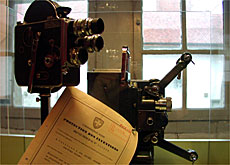Camera exhibition focuses on Bolex

Marlène Dietrich had one. So did the Aga Khan, Andy Warhol, Antoine de Saint-Exupéry and Mahatma Gandhi.
The Swiss-made Bolex movie camera was a sought-after item in the 1930s. And like many of the films it recorded, it went on to achieve legendary status.
Today the Bolex H 16 is still being produced in a factory at Yverdon in canton Vaud. The 16mm camera, which has outsold all its competitors, is now the subject of an exhibition at the town’s history museum.
Tropical rain forests, the icy wastes of Antarctica and the searing heat of the African desert have all been locations for feature films and documentaries shot by the Bolex H 16.
It has even had its own rôle in a 1969 movie – “Swissmade” directed by Fredi M. Maurer and set in the Switzerland of 2069. The film featured a robot equipped with a (Swiss-made) Nagra sound recorder and a Bolex camera in its head.
The camera’s history goes back a long way, to an early 19th century workshop at Sainte-Croix in the Jura region of Switzerland. It was there that Möise Paillard began a watch-making business that later diversified into the manufacture of music boxes, gramophones and Hermes portable typewriters.
Swiss precision
But in the 1930s, Paillard – by now a family concern – zoomed in on a sector which like watch-making went on to become a byword for Swiss precision.
A member of the family came into contact with Jacques Bogopolsky, a Ukrainian who had started a business making movie cameras in Geneva.
The Paillard company took over the business, and appointed Bolsky – who by then had shortened his name – as engineering consultant to the newly-created Ciné-Bolex.
Paillard-Bolex underwent a massive expansion, and by the 1960s employed nearly 6,000 people in Yverdon and Sainte-Croix. It became the biggest industrial employer in French-speaking Switzerland.
But despite its success, the company had problems within the workforce. For generation after generation, the Paillard family had been firmly in control, and there was growing unrest about low salaries.
Thomas Perret, a historian at Neuchâtel University told swissinfo: “The unions and their members were looked upon as enemies, unwanted within the core of the enterprise.”
This could have contributed to the slow decline of Paillard. “I can’t prove this,” said Perret, “but it’s a plausible hypothesis.”
Business decline
But what is sure is that the advent of even more user-friendly cameras made by competitors had an effect on Bolex sales and, although the company adapted to change, business began to decline.
More changes soon came – quartz watches revolutionised the watch-making sector, computers replaced typewriters and, of course, video recorders began replacing film cameras.
In 1969 the Austrian firm, Eumig, bought a majority stake in the company, which was renamed Bolex International, and eventually manufacturing operations were transferred abroad.
Eumig went bankrupt in 1981. The Bolex brand was bought back by the director of Bolex Switzerland and limited production of the H 16 Bolex (no one seems to remember what the letter “H” stands for) continues in Switzerland.
It is still made to order in Yverdon by a small team of skilled craftsmen. As retired head of production Fritz Kramer puts it: “Despite everything, the camera remains a prestigious object, solid and made to last a lifetime.”
To prove Kramer’s point, many of the original Bolex cameras from 70 years ago are still in use all over the world.
swissinfo, Urs Maurer
1814: Möise Paillard opened a watch-making workshop at Sainte-Croix in canton Vaud.
1930: Paillard took over the small Bolex factory and became involved in the production of cameras and projectors.
1935: The Bolex H 16 made its first appearance on the market.
1969: An Austrian form, Eumig, bought a majority stake in the company, which was renamed Bolex International, and manufacturing was transferred abroad.
1981: After Eumig went bankrupt the Bolex brand was bought back by the director of Bolex Switzerland.
2004: A small team of craftsmen in Yverdon continues the manufacture of the Bolex H 16 to order.

In compliance with the JTI standards
More: SWI swissinfo.ch certified by the Journalism Trust Initiative

You can find an overview of ongoing debates with our journalists here. Please join us!
If you want to start a conversation about a topic raised in this article or want to report factual errors, email us at english@swissinfo.ch.